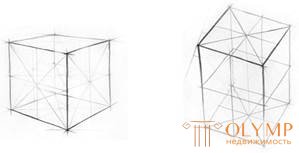
The perception of volumetric-spatial forms is based on the properties inherent in all architectural volumes and used in architectural composition. These properties are as follows:
- geometric view;
- position in space;
- value;
- weight;
- texture;
- light;
- Colour.
Consider each of these properties within their possible changes.
The form of the composite element is determined by: the stereometric character of the outline of the surface of the figure; the ratio of the size of the form in three coordinates. Compositional elements according to the character of the stereometric outline can be divided into several groups.
The first group includes the forms formed by parallel perpendicular planes, the cube and parallelepiped.

Picture 1
The second group includes the forms formed by planes and having non-perpendicular faces - pyramids, prisms, polyhedra.
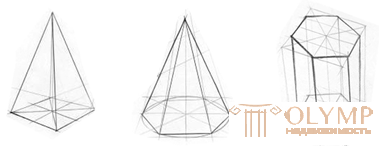
Figure 2
The third group includes all the bodies of revolution and shapes formed by curved surfaces — a ball, a cylinder, a cone, forms with parabolic and hyperbolic surfaces, etc.
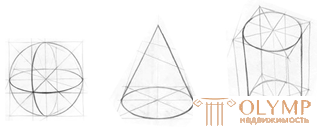
Figure 3
The fourth group includes an infinite number of complex stereometric figures with rectilinear and curvilinear surfaces (Fig. 4).
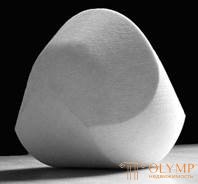
Figure 4 - Monostatic body (gembets)
In the architectural composition of the most commonly used the first group of figures - cubes and parallelepipeds. This is due to the following circumstances:
• rectangular elements are most convenient for organizing life processes and orientation of a person in space;
• rectangular elements are easily connected in groups;
• the internal space of rectangular elements can be easily divided into similar smaller spaces;
• the vertical and horizontal planes of these elements correspond to the most developed structural rack-and-beam system.
Forms of other stereometric bodies are more difficult to combine with each other. Their use is effective in special cases, when organizing single large spaces. The shape of the composite element, depending on the ratios of measurement values in three coordinates, can be three-dimensional, planar, and linear.
The volume form is characterized by the relative equality of the values in three coordinates. The most typical volumetric shapes are cube, ball. In these figures, the measurements in three directions are equal.
The planar form is characterized by development in two coordinates with the subordinate third. The most typical example is a planar parallelepiped.
The linear form is characterized by the predominance of one measure of any kind over the other two.
This property is defined by the relation: to the axes of coordinates (horizontal: X and Y; vertical: Н), to the viewer, to other forms. According to the location between the forms can be: at some distance, abut each other, crash into each other. The most active interposition in the composition is the insertion of one element into another. The most passive is the junction (Fig. 5).

Figure 5
The size of the form is considered as the ratio of the length of the form in three coordinates, as the ratio of two or more forms among themselves and in relation to a person (Fig. 6).

Figure 6
This property of volume-spatial forms, which has a number of features:
- with a change in shape in size, with other things being equal, the mass changes; therefore, a larger form is perceived as more massive (Fig. 7);
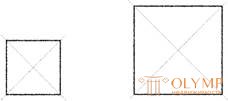
Figure 7
- the massiveness of the form varies depending on the degree of bulk, density or its linearity. Associative perception is also influenced by the stereometric shape of the form. With the same amount of substance, of which bodies, a cube, a ball, a cylinder, etc., are perceived to be more massive than forms, approaching linearly in their proportions (Fig. 8);

Figure 8
- massiveness depends on the density of the form filling material;
- on the massiveness of the forms affects the material from which it is made, its color and texture. Cubes of glass and wood of the same size are perceived differently. A glass cube is perceived to be lighter due to its transparency, although its physical weight is greater than that of wood (Fig. 9).

Figure 9
Under the texture refers to the nature of the surface of the layer of artwork, which is directly perceived by the viewer. Based on the general definition of the spatial form, the texture can be considered the nature of the surface of various scales - from roughness to the degree of dissection of the plane of the facade of the building. The texture to a certain extent characterizes the spatial form and has always been one of the means of artistic expression. Expressive possibilities of texture are revealed by light - one of the most important means of demonstrating the artistic qualities of a spatial form.
Light provides the opportunity for the viewer to perceive the volume, surface and space. With a changing direction of illumination, the same form produces a different impression; for example, the same eaves of a building, depending on the time of day, year, and geographic object, can create shadows of different depths. The distribution of light and shade during the perception of volumetric-spatial forms can vary from complete darkness to maximum illumination. This can depend on both the direction of the light and the strength of the light source. Under extreme states of chiaroscuro, form perception is difficult. The nature of chiaroscuro is also influenced by the distribution of reflected light from surrounding surfaces. The perception of form enriches reflexes - gradations of light and shade, appearing as a result of illuminating objects with reflected light. The brightness and color of the reflexes depend on the illumination and the properties of the reflecting surface.
Light and shade, as well as texture, is directly related to another form-building property of three-dimensional bodies - color.
A distinction is made between the color of light falling on the spatial form or the chromatic structure of the visible spectrum, and the color of the body, that is, its own color of the form.
The visible spectrum consists of a warm gamut (yellow - orange - red colors and intermediate states) and from a cold gamut (green - blue - violet colors and intermediate states). The original primary colors are three colors: red, yellow and blue. Mixed in pairs, they give the rest of the spectral colors. The sum of the three original colors is white (achromatic) color.
Color can be classified into categories such as: color tone, saturation and brightness.
Color should be considered as an additional component that can reveal, but can also visually deform, destroy the volumetric-spatial form. Color is one of the means of construction and, especially, the identification of form. Using the features of color, you can compensate for the shortcomings of the form or emphasize, strengthen the characteristics. This especially applies to spatial compositions. Combining cold and warm colors, saturation and amount of color, you can illusoryly expand the space, create a feeling of spaciousness or, on the contrary, as if to bring closer the volumes that organize the space to the viewer.
Visual equilibrium in the perception of spatial forms - this is the arrangement of the elements of the composition, in which each object is in a stable position, and vice versa, “an unbalanced composition looks random, temporary, and therefore unfounded. Its elements tend to change their place and form in order to occupy a position that better satisfies the overall structure. ” Balance is always determined by the visual axis (see fig. 10-11).
Position A
Two identical parallelepipeds, standing on the same line as the front, form a symmetric and balanced composition - the axis of equilibrium passes through the geometric center and coincides with the axis of symmetry.
Position B
One of the elements is enlarged while maintaining mutual positions. Elements become different in silhouette and mass, they are compared, compared. A larger volume subordinates a smaller one. Since attention shifts to a larger volume, the axis of equilibrium is immediately shifted in his direction. The composition becomes asymmetric. The greater the difference between the elements, the more actively the axis moves from the center, as a result of which an imbalance may occur. In a frontal asymmetric composition, the visual equilibrium of its elements is usually determined by the position of the axis within approximately the middle third of the composition field. If the visual equilibrium is disturbed, i.e., the equilibrium axis is outside this zone, it is necessary to restore it by returning the axis to the required limits.
Position B
With this position of the elements (on the same line along the front) and a slight increase in the smaller element, the reduced mass of both elements becomes relatively different — the balance axis moves to the center, and the composition is again balanced.
Position G
If the smaller parallelepiped from the position of the first position is advanced, it immediately takes an active position in relation to the larger. The balance axis is again in the center of the composition.
Position D
The smaller element is at an angle to the larger one and at the same time pushed forward. As a result of moving the elements and changing the mass, the axis of visual balance moves to the left, then to the right, an “oscillation” of the axis of balance occurs.
The description of the work on the composition of two elements is given not because it is an easy task to solve, but only for reasons of greater clarity. It is rather difficult to build an expressive and integral composition of asymmetric nature of two elements - the axis of equilibrium in these compositions responds very sensitively to the slightest change in mass and position in space, therefore, in finding solutions to such problems, the sense of balance should be particularly acute.
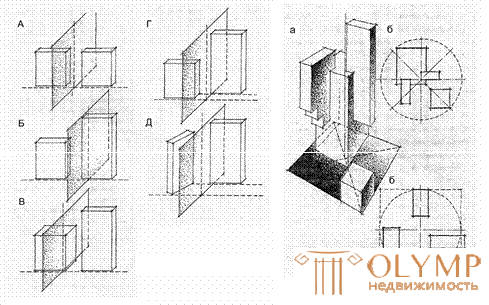
Figure 10 - Diagrams demonstrating the search for equilibrium in the process of solving a composition
The composition will appear balanced when the projections of all its constituent elements on the horizontal plane fit or almost fit into a circle or a square. This means that the bulk condition is met.
Что бы оставить комментарий войдите
Комментарии (0)